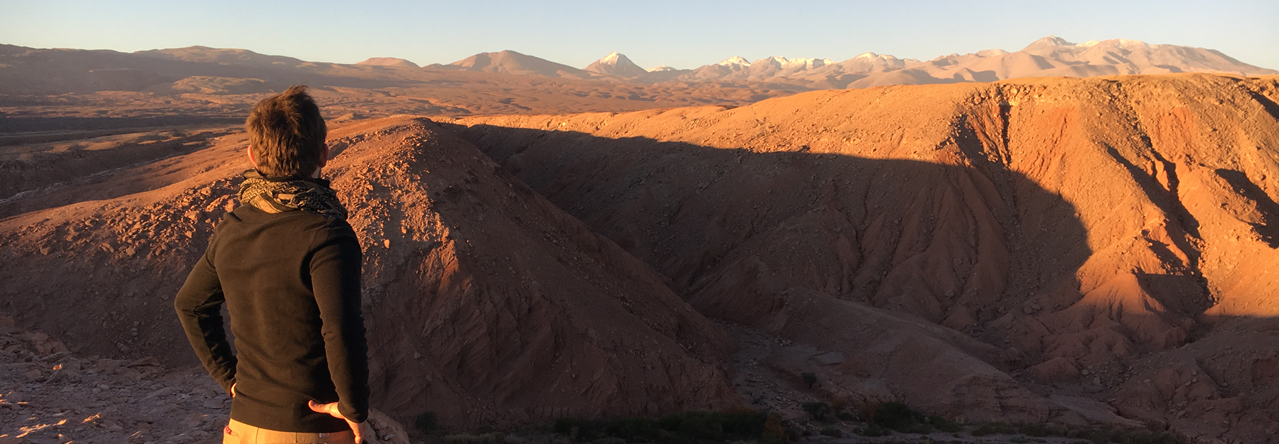I can tell the sea is much calmer as soon as I wake this morning. Checking the TV itinerary shows we continued to make good time; we now have a landing at Half-Moon island and Cámara Base this afternoon.
After breakfast, we have a very long safety and IAATO briefing. Antarctica is the world’s last pristine wilderness and people are serious about keeping it that way. All of our external gear has to be inspected and decontaminated so we don’t bring any foreign flora or sickness to the Antarctic. The…

- How do ship stabilizers work?
- Why would we want ours turned off?

ship even has an IAATO observer on board to ensure the expedition complies with all these standards.
Luckily, we are able to avoid most of the decontamination hassle because our gear is either brand new or our ship-issued survival suits for kayaking.
11:30 – Just before lunch we sight land. The South Shetland Islands are a small archipelago that protects Antarctica from the sea on this side. We’ll weave through them and approach Half-moon Island from the continent side.
Fun fact: Alexandria and I were in the original, north, Shetland Islands this time last year for Up Helly Aa.

15:00 – We’ve begun our loop “behind” the South Shetland Islands on the continent side. The mood is light and excited. Although whether that is for our first landing or for these calmer waters is hard to tell. Many people are already suited up outside watching the islands and truly massive glaciers pass by.
On New Year’s Eve, we went to a party at the Faena Hotel in Buenos Aires. We met some Americans just returning from Antarctica who commented on how impressive the sheer scale of the place is. Even seeing these first small islands and glaciers really underscores…

- What does Cámara Station research?

how right they were. And we still haven’t seen the continent — an unbroken expanse of snow and ice the size of North America.
I can see on the ship’s nav that we are near Cámara station. I head out to the bow to try and glimpse our first stop with my binoculars (one of my best purchases, by the way). I can see it on the horizon but the wind nearly takes my glasses, even tied around my neck as they are. …at least we are still getting intermittent sun!
No sooner do I finish wrangling my glasses back on my face than I hear the clatter of the massive chains holding our anchors. The overly friendly series of tones that serve as prelude to an announcement come across the…

ship’s PA. The announcement is calling the kayak team to stations. Now Alexandria and I have to race to get into all of our survival gear for the first time and to remain on schedule for deployment.
As is always the case we rush out the door, arrive just in time… and then need to wait around for 20 minutes…
For kayaking we head out on zodiac craft away from the ship and then roll off the rafts into the kayaks. An easy enough plan. That is until you look back and see half the kayaks you were towing detached and drifting over the horizon and into the Antarctica Ocean. Luckily it’s for…

situations like this that we have powered boats! A wee bit of wrangling and we were once again sorted. Alexandria and I were the first to attempt the maneuver of jumping from raft to kayak in the open ocean (*because I volunteered us) and all went smoothly. In fact, things went mostly smoothly for everyone. Despite this, it is clear the divide in kayaking teams; the Coloradans and Oregonians are far and away the most adept…
Our luck is continuing unabated and the sun is filtering through the clouds. This is really just a trial run so we go along the coast and run some obstacle courses.

After kayaking we reversed manoeuvers and rolled from kayak to zodiac. We opted to go ashore with the rest of the ship. A decision we both regretted in the end. It was cool to get up close to the penguin colonies and the views were amazing. But even so, it’s a hassle to trek around when attired for kayaking. If going ashore was all I was able to do on one of these expeditions I’d be bored quick. Discussing this later, Alexandria pointed out that it isn’t dissimilar from game drives on safari. However, I think game drives hold more excitement because so many small or big things happen in ecosystems with so many…

animals interacting. Down here we are pretty much just watching penguins so I’m not sure how much variety that’ll provide. We saw spades of penguins on this first stop. The contrast between a penguin in the water and one on land is stark. In water, they’re sleek and fast and my favorite time to see them is when they’re “porpoising”, jumping out of the water. On land, they’re just plain comical. we saw a good variety of seals as well. Though, to my eyes they just look like driftwood. Luckily, we don’t have trees in the Antarctic so I can be confident any logs I see are, indeed, seals.
back on board we…

were treated to the fourth sunny evening of the prior two months. This brought an amazing and slow sunset behind the South Shetland Islands as we left them and made for the continent proper.









































